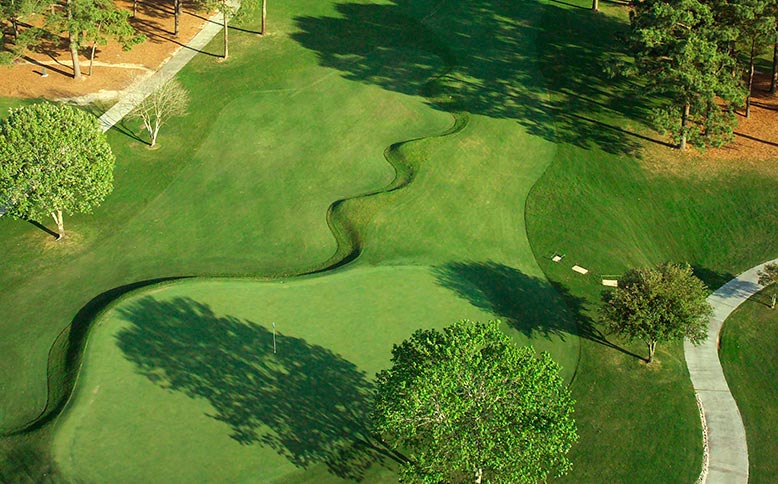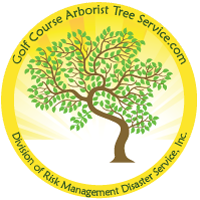
We serve golf courses nationwide with tree beautification, tree management, as well as emergency tree services after storms and disasters. Our arborist and tree service use lean management methods, giving your golf course more tree services for every dollar you invest.
Arborist and tree service teams who know golf courses
You will elevate your golf course in the minds of golfers with a tree beautification project. Customized services can include tree trimming, tree removal, shade and tree studies, lightning protection, arborist consulting, and more. We can be on site quickly after a storm to restore your golf course, like we did for Lochinvar Golf Club in Houston, Texas when it was damaged in 2008 by Hurricane Ike, or Princess Anne Country Club in Virginia Beach following Hurricane Isabel.
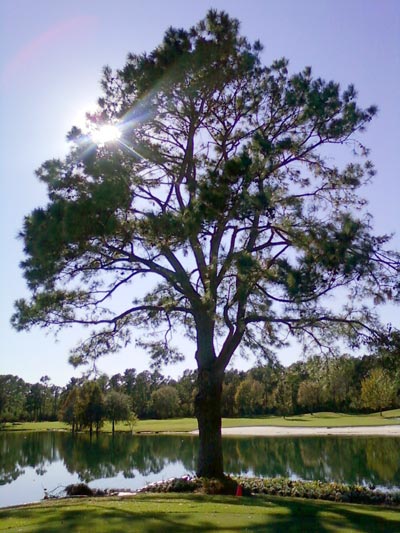
We understand golf course tree management. Our tree services don’t sacrifice playability because our staff includes a current golf pro, a former certified golf superintendent, and a consulting arborist for the 1996 Olympics.
We have skilled crews ready, willing, and able to work nationwide and worldwide. We are cost competitive because we practice lean management, a process of eliminating waste and delays by balancing your requirements with the strategic use of our equipment and personnel. We offer substantial savings when we provide tree service to several golf courses at once in an area, allowing us to better mobilize our equipment and staff.
We recycle our woody waste material into usable products like our premium mulch designed for playability or landscaping on your golf course, saving the expense of landfill dumping and lowering your cost.
Our maintenance tree trimming is backed with a 3-year warranty, meaning we retrim a tree for free should that be necessary. We work carefully with specialized equipment so we won’t damage your golf turf. We deliver your project on time and on budget. We take pride in revealing the natural works of art hiding within your trees, so your golfers notice how beautiful your golf course looks compared to others.
Please call or email for more information about our arborist tree services. The articles on this page explain in detail our philosophies for improving your golf course.
The need for golf course tree management
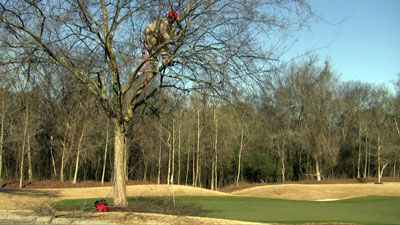
Trees influence the game of golf in many ways. Trees frame the golf course. They define the field of play. Trees offer golfers privacy and seclusion from adjoining tees, fairways, and greens. Trees protect golfers, homes, buildings, and cars from errant golf shots. Trees cause golfers to choose their strategies for playing a hole.
When a golfer stands on a tee and views your golf course trees, what does he see? Is he disheartened because over the years, large limbs have grown out over the tee or fairway to make the shot seem harder than it looked years earlier?
Does the landscape create a sense of invitation and he is captivated by the natural beauty of the trees framing the course that can only result from them being cared for properly?
Have unmanaged golf course trees grown over the years into ordinary backdrops now ignored by the eye? Or are the trees on your golf course tailored by an arborist that understand that golf is business and that the trees have to encourage players to choose your course over the other course. Our golf tree service will train your trees to grow into magnificent shapes of art adding value to your fairways and greens.
Arborist and tree service teams who know golf courses
You will elevate your golf course in the minds of golfers with a tree beautification project. Customized services can include tree trimming, tree removal, shade and tree studies, lightning protection, arborist consulting, and more. We can be on site quickly after a storm to restore your golf course, like we did for Lochinvar Golf Club in Houston, Texas when it was damaged in 2008 by Hurricane Ike, or Princess Anne Country Club in Virginia Beach following Hurricane Isabel.

We understand golf course tree management. Our tree services don’t sacrifice playability because our staff includes a current golf pro, a former certified golf superintendent, and a consulting arborist for the 1996 Olympics.
We have skilled crews ready, willing, and able to work nationwide and worldwide. We are cost competitive because we practice lean management, a process of eliminating waste and delays by balancing your requirements with the strategic use of our equipment and personnel. We offer substantial savings when we provide tree service to several golf courses at once in an area, allowing us to better mobilize our equipment and staff.
We recycle our woody waste material into usable products like our premium mulch designed for playability or landscaping on your golf course, saving the expense of landfill dumping and lowering your cost.
Our maintenance tree trimming is backed with a 3-year warranty, meaning we retrim a tree for free should that be necessary. We work carefully with specialized equipment so we won’t damage your golf turf. We deliver your project on time and on budget. We take pride in revealing the natural works of art hiding within your trees, so your golfers notice how beautiful your golf course looks compared to others.
Please call or email for more information about our arborist tree services. The articles on this page explain in detail our philosophies for improving your golf course.
The need for golf course tree management

Trees influence the game of golf in many ways. Trees frame the golf course. They define the field of play. Trees offer golfers privacy and seclusion from adjoining tees, fairways, and greens. Trees protect golfers, homes, buildings, and cars from errant golf shots. Trees cause golfers to choose their strategies for playing a hole.
When a golfer stands on a tee and views your golf course trees, what does he see? Is he disheartened because over the years, large limbs have grown out over the tee or fairway to make the shot seem harder than it looked years earlier?
Does the landscape create a sense of invitation and he is captivated by the natural beauty of the trees framing the course that can only result from them being cared for properly?
Have unmanaged golf course trees grown over the years into ordinary backdrops now ignored by the eye? Or are the trees on your golf course tailored by an arborist that understand that golf is business and that the trees have to encourage players to choose your course over the other course. Our golf tree service will train your trees to grow into magnificent shapes of art adding value to your fairways and greens.
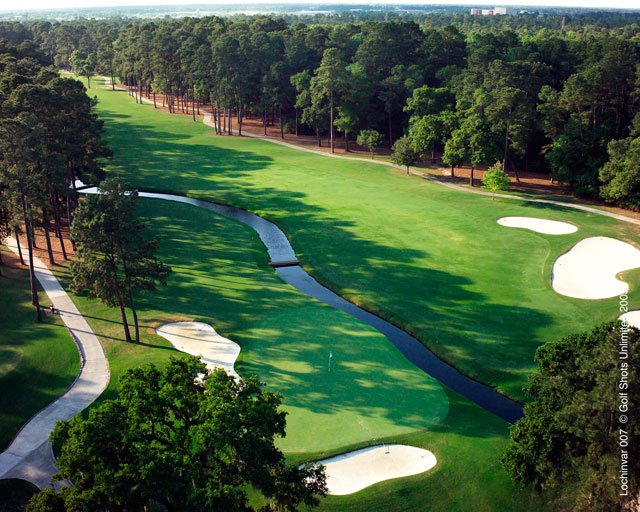
Golfers marvel at how much better a golf course feels when attention is paid to the trees to create an image and atmosphere that relieves them from their daily cares. Golfers are people too, and all people need an escape.
The effects of proper golf course tree management will be obvious to golfers. Standing on a tee and looking down the fairway, the view of carefully trimmed trees comprise stunning landscapes. Approaching a properly pruned tree along a golf cart path reveals a sculpture captivating the eye.
A golf course that benefits from the vision of an artistic and business-minded arborist’s tree plan and proper pruning by a knowledgeable golf course tree service will look dramatically different in future years.
Trees as landscape art
When a golf course architect plans a new course, he provides scenic vistas using trees to define the beauty of each hole. But that beauty degrades over the years when unmanaged and unruly trees alter those views. A golf course arborist tree service returns the course to its original splendor through careful pruning, tree trimming, and strategic tree removal performed in harmony with a master tree management plan.
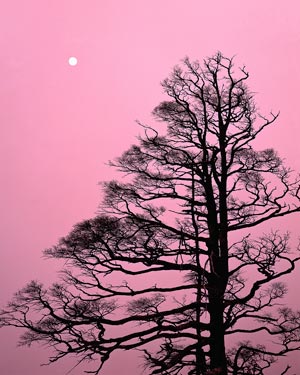
Trees pruned by a trained arborist and tree service emerge into magnificent works of art that captivate the eye to form dramatic views that make the golf experience memorable. Every golf course has a hole for the golfer to shoot for, but no other course can have your views — the views Golf Course Arborist Tree Service created for you.
Our arborist tree service knows how to artistically prune a golf course tree’s crown to improve the tree’s presence. Knowing exactly which tree branches to remove within the tree canopy, and which to leave, results in a tree that will grow into a natural shape over the years. You must understand that you have trees exposed to indirect light this confuses a trees growing behavior and we know how to give it the guidance it needs to look natural again.
Proper crown thinning exposes the artistic shapes primary branches to the eye and shows off the tree trunk. A pruned tree becomes a sculpture along the fairway as areas of sky peek through the leaves to contrast with the foliage, catching the attention of golfers who pass by and marvel at the beautiful experience and feeling produced as the tree complements their golf experience.
When the sunlight penetrate the tree to light up the foliage in dramatic ways then a tree previously lost along a golf course fairway is now spotlighted to become a focal point when viewed from the fairway.
But proper pruning by a golf tree service does more than make a tree more attractive, and improves the tree’s future health. Sunlight now penetrates inside the tree canopy through the open spaces a golf course arborist creates, and that sunlight encourages healthy growth.
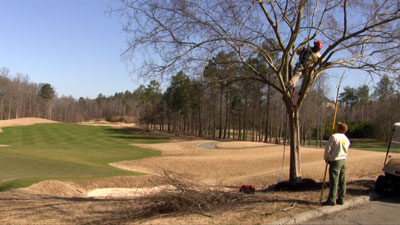
Wind can now easily pass through the tree, so tree leaves don’t remain overly damp encouraging diseases or insects to thrive. Letting wind pass through the tree also helps the tree withstand the forces of storm winds that might otherwise topple it or cause branches to break. Proper trimming by a golf tree service can reduce the risks of losing your valuable landscape when a hurricane, tornado, wind storm, or ice storm strikes.
Hiding within a typical golf course are specimen tree species, often 50 to 100 years old, which are presently obscured by surrounding trees, brush or vines. Your golf course tree service can rescue them from obscurity by clearing the surrounding space, and then give them a makeover to enhance their appearance.
Trees and turf management
Proper tree management benefits your golf course turf in several ways. A golf arborist can advise you if nearby trees are causing the turf maintenance problem you have on a fairway, tee, or green. This is often the case, because trees harm turf by blocking sunlight, reducing water and wind, and dumping tree debris on sensitive turf.
Overly shady areas that thwart turf growth can be eliminated by having your golf tree service trim branches to open up areas within the tree. Tree removal is sometimes needed, because many golf courses are overgrown with too many trees once they mature.
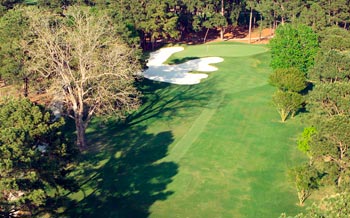
Getting morning and afternoon sun to reach turf areas is accomplished by having your golf tree service thin the stands of trees lining fairways. Once small trees and underbrush are removed, and unnecessary limbs on large trees pruned, a lot more sunlight reaches the grass in mornings and evenings. The additional sun may enable grass to green faster in spring, so golf play can begin sooner.
Irrigations costs are lower when golf course trees are properly managed. Removing excessive trees or trimming foliage reduces the water needs of trees, so their root systems will not suck away moisture needed by turf. Root pruning can control turf problems. Roots can be cut off using a trencher and a permanent barrier installed so roots don’t intrude into sensitive turf areas like greens and tees.
Tree roots can extend out from the trunk one and a half times the height of the tree. An 80-foot tree can have roots reaching 120-feet from the trunk. For this reason, trees shouldn’t be planted nor left growing closer than 80 feet from a green or tee, as the roots will likely cause turf to weaken.
Thinning trees can improve the air circulation that helps turf avoid disease problems. Raising the tree canopies above the turf can help wind circulation.
Turf can suffer maintenance headaches when trees litter it with needles, leaves, buds, nuts, twigs and bark. A golf course tree service can help with a problematic tree by trimming it, moving the tree to a better location, or removing and replacing it with a better species of tree.
Surface roots are another issue when they disrupt the golf field of play or cart paths. Our golf tree service can eliminate problem roots.
Golf course tree maintenance

Corrective pruning to remove dead, storm damaged or diseased branches is often accomplished by your own golf course maintenance staff. Some golf courses get behind in pruning since turf maintenance takes priority, so you may periodically need to turn to an outside golf tree service to catch up on tree maintenance.
You should always consider an outside golf tree service for selective pruning, which requires more knowledge often not found in a maintenance worker who simply knows how to saw. Selective pruning is the art of knowing which tree limbs to remove in order to encourage a better future for the tree’s appearance and health. Knowing the correct methods to make these cuts is essential, or harm can be done to the tree.
Correct pruning helps avoid future problems that impact the golf course play or maintenance. For instance, removing a main branch today may prevent that tree from later intruding on the golfer’s view when making a shot off the tee or to the green. Selective pruning by your golf tree service avoids future turf problems created by shade or lack of air circulation.
Proper pruning can stimulate flowering trees to bloom better, or to stimulate healthier growth in stressed trees.

Selective pruning can keep some trees to a manageable size relative to golf play or turf maintenance. The tree’s growth cycle is reduced by pruning right after the tree’s spring growth finishes. A stand of trees that is overcrowded can be corrected by pruning the crowns of the less desirable trees. This lets desirable trees expand their canopies, and eventually the less desirable trees can be removed. Reducing the clutter improves the landscape.
Younger trees need to be trained with selective pruning to reach their future potential.
Selective pruning is best done by the golf tree service when the tree is dormant in winter months, and before the natural spring cycle of growth begins. In deciduous trees, up to a third of the branches are trimmed within the tree canopy to promote tree health. Less of the canopy should be removed in conifer, eucalyptus, walnut, beech, and birch trees.
Our golf tree service or golf arborist will inspect trees for signs of insects and disease. In some cases, the outside tree service has the equipment or expertise needed to treat a tree’s problem, but in other cases the tree service instructs your maintenance staff how to cure it. Controlling insects of disease may require using sprays, pruning the tree, or removing it altogether so the problem doesn’t spread to other trees. A few of the problems we look out for: anthracnose, aphids, armilaria root rot, bark beetles, fire blight, oak worms, pitch canker, and powdery mildew.

Index to topics
- The need for golf course tree management
- Trees as landscape art
- Trees and turf management
- Golf course tree maintenance
- Golf course tree management
- Trees and playability
- Trees and golf course safety
- Golf course construction
Golf course tree management
Golf course turf receives plenty of maintenance, but often tree management and tree maintenance are overlooked in the golf course management budget. As a result, over the years, a golf course where tree management was neglected is in need of a one-time tree renovation project by an outside golf tree service. An assessment by a golf arborist tree service can provide the documentation needed to secure budgeting for these needed tree services.

Bringing in an outside arborist who knows golf courses helps resolve different opinions between club management, superintendent, and golfers who can’t agree on which trees need trimming or removal. Removing any tree is usually a tough and controversial decision to make, without an arborist to explain the long-term benefits to golfer’s play and future of the golf course.
Trees that aren’t managed will degrade a golf course over time. The course no longer plays as the golf course architect intended. Unmanaged trees reduce the field of play, make it hard for golfers to see shots to the green, increase the time needed to play a round, and make a golf course less fun to play.
Golf courses fortunate to have scenic views of water, mountains, canyons or skylines could consider removing or trimming trees that have grown large and now obscure the vistas at critical viewing points throughout the golf course.
Turf is harmed by trees that provide too much shade, block air circulation, and deprive grass of water and nutrients. In short, ignoring tree management increases the costs of managing and maintaining the golf course.
The first step in a tree management program is to inventory and map all the significant trees along the golf course fairways. Our tree service crew and arborist can create a GPS map of your trees atop aerial photos.
Each tree is valued on criteria:
- Is it a desirable tree species?
- What is the value of the tree?
- How long may the tree live?
- How healthy is the tree?
- How fast does the tree grow?
- Does the tree create turf maintenance problems?
- Does the tree contribute to the artistic landscape of the golf course?
- Does the tree obscure a scenic view or the golfer’s need to see the green?
- Does the tree provide safety to golfers or buildings by blocking errant shots?
- Does the tree help or hurt the playability of the golf course?
- Does the tree slow course playing time?
- Does the tree need attention: pruning, thinning, moving, removal, disease or insect treatment, fertilization.
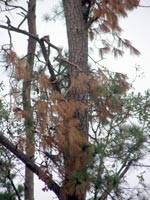
Trees are physically marked with identification numbers, and a color code on the trunk can indicate its status: prune, remove, move, and leave alone. Trees can be color coded if they need attention: disease, insects, and fertilization.
Trees don’t last forever; they have a life cycle like all living things. A golf course arborist in his plan will identify the trees that will need replacement in the future, so their replacement trees can be planned and planted beforehand. Desirable specimen trees are protected by removing less desirable competing trees.
Trees and playability
As golf course trees grow rapidly, the playability may no longer be the same as envisioned by the golf course architect.
The wider fairway landing areas when the course was created look very different to a golfer’s eye once trees along the field of play extend limbs over the years. Compare an old photo of a fairway when the course was built to the same view today, and you usually see that fairway looks narrower than was intended by the golf course architect. This has a psychological effect on the golfer’s decision on how to play the hole, since the easy shot seen when the course first opened now appears much tougher than it is.
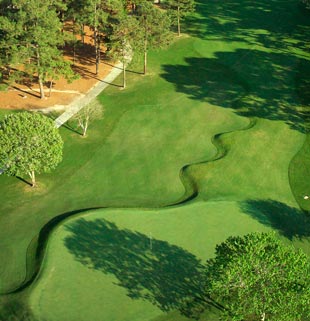
Golfers standing on the tee today seeing this seemingly narrow view will play the hole cautiously. To restore their confidence that there are large landing areas and room for a longer or wider shot, your golf tree service needs to remove the tree limbs that intrude over the fairway. The goal is to recreate the original fairway view from the tee.
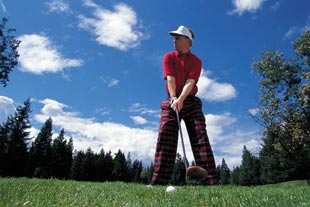
Similar playability problems occur on dogleg holes where views from the fairway to the green are now obscured by overgrown trees.
Another issue is balls are landing on new areas of the fairway than the golf course architect intended because today’s better golfers hit the ball further, with the aid of better balls and clubs. The view from these new landing areas to the green may need to be improved by having your golf tree service remove problematic tree limbs or trees.
Having your tree service trim or remove trees can result in golfers playing the hole in fewer shots, speeding up course play. For instance, visualizing a menancing tree ahead can cause a golfer not to use a longer driver as he should.
Players waste time searching for balls in overgrown forest areas, often dark with too much shade. Thinning these areas, and opening tree canopies to allow sunlight in and provide better views to the green, can speed up play.
Trimming or removing golf course trees also eliminates turf maintenance problems. The perception of threatening trees ahead causes golfers to overuse one side of the tee to make shots from, or land in one spot of the fairway, causing wear on the turf.
Trees and golf course safety
The distance that golf balls travel is growing as golfers become better skilled and the technology behind golf balls and golf clubs advances. Protecting nearby golfers from long shots is an important benefit provided by strategically placed trees along fairways, greens, and tees. Homes and buildings adjoining need the protection offered by strategically placed trees that won’t impact views of the golf course.
Over the years, a golf course arborist must continually plan future plantings to protect golfers and buildings when new construction occurs on previously undeveloped land, or as golf course trees disappear due to old age, disease, insects, storms, or drought. A new tree may be planted now to eventually grow big enough to replace a nearby tree that isn’t expected to survive long.
Lightening protection is another concern that a golf course arborist considers. A tall tree can keep a golfer from being struck by lightning, providing the golf tree service has outfitted the tree with a lightning rod to safely ground the strike.
Golf course construction
Using an experienced golf course arborist and golf tree service to clear land when building a course makes a tremendous difference on its future. Clearing isn’t a matter of having guys with saws quickly cut trees. Clearing should be done in a thoughtful process to compliment the design of the golf course architect. Trees are best removed gradually in stages, carefully reviewing the landscape before removing more trees.
Our experienced golf course tree service will know which valuable species of trees to keep along fairways, and which to remove. Our golf course arborist can identify any tree that should be removed because they will create problems for turf management or golf play. Our arborists preserve signature trees which enhance the beauty and playability of the game.
Golf courses with mature trees that retain a natural look are treasured. Non-native trees overly planted on a course will make it appear artificial.


